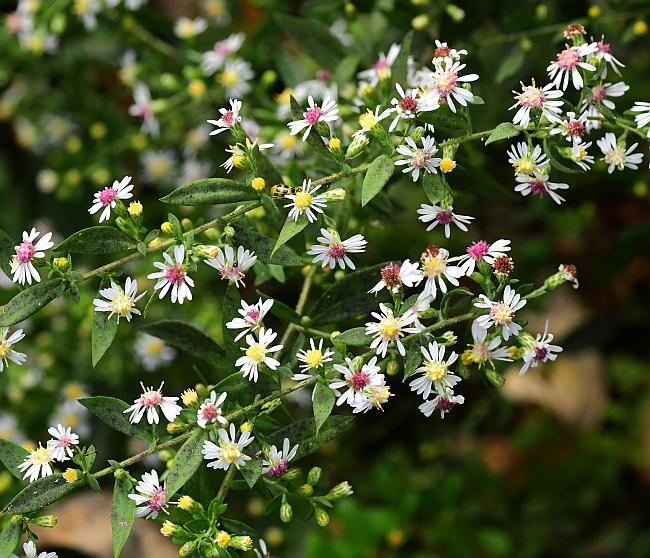Symphyotrichum ontarionis (Wiegand) G.L. Nesom
Ontario Aster

Native
CC = 3
CW = 0
MOC = 38
© SRTurner
Symphyotrichum ontarionis (Wiegand) G.L. NesomOntario Aster | |
 |
Native CC = 3 CW = 0 MOC = 38 |
© SRTurner |
|
Family - Asteraceae/Astereae Habit - Perennial forb, often somewhat colonial from relatively long, slender, branched rhizomes. Stem - Ascending to erect, to 1.2 m, usually solitary, unbranched or with several ascending to spreading branches above the midpoint, sparsely to moderately pubescent with short, spreading hairs, these relatively evenly distributed toward the stem tip, often only in longitudinal lines or bands toward the stem midpoint, very sparse or nearly glabrous toward the base.
Leaves - Alternate, simple, sessile or short-petiolate. Basal and/or lower stem leaves usually absent at flowering, sessile or with a short, poorly differentiated petiole, the blade 2-8 cm long, 0.5-3.5 cm wide, oblanceolate to obovate, tapered at the base, angled or tapered to a usually sharply pointed tip, the margins bluntly to sharply toothed, usually sparsely pubescent with minute hairs on the surfaces, the secondary veins on the leaf undersurface fine but usually relatively easily observed, often irregularly fused toward their tips, the veinlets often indistinct, forming a dense, irregular network of relatively short areoles. Median and upper stem leaves progressively smaller, sessile, the base sometimes slightly expanded but not clasping the stem, the blades 1-12 cm long, narrowly elliptic-ovate to lanceolate, oblanceolate, the uppermost leaves usually with entire margins and occasionally linear, angled or tapered at the base, the surfaces sparsely to moderately and relatively evenly pubescent with minute hairs along and in between the veins, sometimes with slightly longer or denser hairs along the midvein, otherwise similar to the lower stem leaves.
Inflorescences - Appearing as panicles with short to relatively long, loosely ascending to spreading, racemose branches, sometimes reduced to a solitary raceme or with heads clustered toward the branch tips, the heads appearing mostly short-stalked and oriented in several directions, the bracts along the ultimate branches 0.6-1.5 cm long, leaflike, linear to lanceolate or elliptic, mostly only slightly shorter than the adjacent foliage leaves.
Heads - Radiate, mostly 0.8-1.5 cm in diameter (including the extended ray corollas) at flowering. Involucre 3-5 mm long, the bracts in 3-5 unequal, overlapping series. Involucral bracts linear to very narrowly oblong-oblanceolate, angled or short-tapered at the usually sharply pointed tip, the tips flat and erect or ascending, the outer series with the narrowly elliptic, green portion reaching nearly to the base, the other series with the slender midvein broadened gradually in the apical 1/3-2/3 into a narrowly elliptic green tip, the surfaces glabrous or sparsely short-hairy, the margins sparsely or irregularly short-hairy.
Florets - Ray florets 15-25 in 1 or 2 series, pistillate, the corollas well developed, 4-8 mm long, white (rarely darkening upon drying). Disc florets 12-25, perfect, the corollas 2.5-4.5 mm long, the slender portion of the tube slightly shorter than the slightly expanded apical portion, the lobes 0.7-1.1 mm long, 45-65 percent of the total length of the expanded portion. Pappus bristles 3.0-4.5 mm long, white to pale cream-colored.
Fruits - Achenes 1.2-2.0 mm long, with 3-5 longitudinal ribs, gray, moderately hairy, the hairs usually with minutely swollen bases. Flowering - August - October. Habitat - Bottomland and mesic forests, swamps, sloughs, streambanks, pond margins, bases of bluffs, pastures, ditches, and roadsides. Origin - Native to the U.S. Lookalikes - Other small white asters, especially S. lateriflorum and S. pilosum. Other info. - This species is found in scattered locations in Missouri, most commonly in counties near the Missouri and Mississippi Rivers. Its range beyond Missouri is concentrated in the U.S. upper Midwest, more scattered southward, and largely absent from the coasts. The plant is easily identified as a Symphyotrichum by the appearance of the flowering heads and involucres; however, the small white asters, of which this species is an example, can be difficult to differentiate with confidence. In particular, this species strongly resembles S. lateriflorum. A key character to look for is the distribution of hairs on the leaf underside. In S. ontarionis, these occur all across the leaf surface, as shown in the leaf-folded image above. This distribution can be termed a "brush cut." In contrast, S. lateriflorum leaves have a "mohawk" distribution, which hairs mostly restricted to the center midvein. Another lookalike, S. pilosum, has involucral bracts that are inrolled (not flat) and bristle-like at the tip, and somewhat looser or spreading in orientation. Photographs taken near Labadie, Franklin County, MO, 10-1-2020 (SRTurner). |